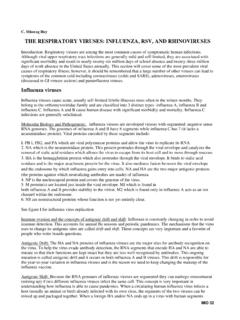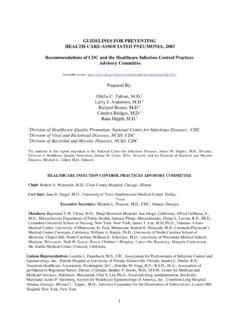Transcription of The Characteristics of Pandemic - Johns Hopkins Center for ...
1 Center for Health Security The Characteristics of Pandemic Pathogens Improving Pandemic Preparedness by Identifying the Attributes of Microorganisms Most Likely to Cause a Global Catastrophic Biological Event Center for Health Security The Characteristics of Pandemic Pathogens p roj ect tea m Amesh A. Adalja, MD, Project Director Matthew Watson, BS. Eric S. Toner, MD. Anita Cicero, JD. Thomas V. Inglesby, MD. Copyright 2018 by Johns Hopkins University e xe c ut ive sum m ary The Characteristics of Pandemic Pathogens Background and Purpose of Report c o ntents 3 Executive Summary t he Johns Hopkins Center for Health Security conducted this study to elucidate the Characteristics of naturally occurring microorganisms that constitute a global catastrophic biological risk (GCBR). GCBRs are defined as those events in which biological agents whether naturally emerging or 8 Introduction 9 Purpose, Methods, and Analysis reemerging, deliberately created and released, or laboratory engineered and escaped could lead to 10 Basis of Recommendations sudden, extraordinary, widespread disaster beyond the collective capability of national and international 18 Recommendations governments and the private sector to control.
2 If unchecked, GCBRs would lead to great suffering, loss of 22 Future Directions life, and sustained damage to national governments, international relationships, economies, societal 22 Conclusion 23 References stability, or global security.. 26 Appendix A: List of Experts Interviewed 28 Appendix B: Meeting Participants The overarching aim of the study was to provide an inductive, microbe-agnostic analysis of the microbial world to identify fundamental principles that underlie this special category of microorganisms that have potential to cause global catastrophe. Such principles could refine Pandemic preparedness by providing a new framework or lens through which to survey the threat landscape of infectious diseases in order to better anticipate, prepare for, and respond to GCBR threats. 3. e x e c u t i v e s u m m a ry e xe c ut ive sum m ary Basis of Recommendations Efforts to create viral catalogs are not synonymous with nor Human factors and/or the occurrence of complex disasters Additionally, as infectious disease outbreaks occur within a necessarily effective as tools of Pandemic preparedness.
3 Can elevate pathogens to GCBR levels. larger sociopolitical, geographic, environmental, and There are several Characteristics likely to be common to economic context, the presence of concomitant complexities GCBR-level Pandemic pathogens. Major resource-intensive efforts are currently under way to During an outbreak situation, early decisions regarding can exacerbate an outbreak and confer GCBR-level status on a develop a global virome to catalog as many viral species on the vaccine policy, resource mobilization, and countermeasure Irrespective of the biological class of a pathogen, several microbe that is unable, on its own, to possess such destructive planet as possible. The rationale behind these projects is to deployment made by political and scientific leaders can be attributes are likely to be essential components of any capacity.
4 For example, the record-breaking 2017 outbreak of develop a full understanding of the breadth of the viral world decisive in the control of an outbreak and could prevent many GCBR-level pathogen. These traits include efficient human- cholera in Yemen, though not rising to the level of a GCBR, and to be able to develop better situational awareness of of the downstream cascading effects that affect the healthcare to-human transmissibility, an appreciable case fatality rate, was significantly magnified by the presence of war. Therefore, looming threats. The scientific value of such an undertaking is and other sectors. Conversely, decisions both scientific and the absence of an effective or widely available medical it is important to realize that outbreaks caused by pathogens substantial and without question.
5 Political that lead to harmful or erroneous actions could countermeasure, an immunologically na ve population, not categorized as GCBR-level risks could rise to that level deepen the consequences of an epidemic or worsen a GCBR. virulence factors enabling immune system evasion, and However, these efforts will not necessarily translate into better through synergy with external factors. respiratory mode of spread. Additionally, the ability to Pandemic preparedness, given the sheer numbers of viruses transmit during incubation periods and/or the occurrence that will be catalogued without a clear means of prioritizing of mild illnesses would further augment spread. them, the fact that most identified viruses will pose little to no threat to humans, and the recognition that, while a viral cause Although most classes of microbe could evolve or be of the next Pandemic is most likely, there is no guarantee it manipulated in ways that would cause a catastrophic risk to will not be caused by another class of pathogen.
6 The cost- humans, viruses especially RNA viruses are the most likely effectiveness of a global viral catalog for diminishing class of microorganism to have this capacity. Pandemic threats may be less than that of systematically pursuing diagnoses of infectious disease syndromes, as Among the various classes of microbes, many possess some or discussed below. all of the Characteristics necessary to be identified as a GCBR. However, several features of viruses make this class of Pursuing diagnoses of infectious disease syndromes provides microbial agents the most likely to cause GCBRs. viruses situational awareness of pathogens that could evolve into possess higher capacity for genetic mutability due to both the Pandemic threats. structure of their genomes and the generation time for replication in which large numbers of progeny virus are Aggressive diagnostic testing of infectious disease syndromes created each day.
7 Additionally, the inability of a virus to be such as atypical pneumonia, central nervous system countered with a broad-spectrum antiviral compared with infections, and septic shock in strategic and sentinel locations bacteria, fungi, and parasites makes viruses the more likely around the world and over time may provide insight into new cause of a GCBR. or changing patterns of infection. Such a practice would be a radical departure from standard practices in both the Within the viral class, RNA viruses merit special concern developed and the developing worlds, in which syndromic chiefly because of their higher mutability compared to DNA clinical diagnosis, basic microbiological testing, and empiric viruses . therapy are often the rule. With the heightened availability of more sophisticated diagnostic testing in both developed and developing nations, it is increasingly possible to have greater insight into the microbiological causes underlying many common infectious syndromes that currently are not routinely pursued to a specific microbiological etiology.
8 Illuminating this biological dark matter that is present in hospitals and clinics worldwide will not only improve treatment but would focus pathogen discovery efforts on established damage-causing microbes. 4 5. e x e c u t i v e s u m m a ry e xe c ut ive sum m ary Recommendations to Prepare for An increased emphasis on developing a specific pipeline of Pursuing microbiologically specific diagnoses of infectious infectious disease syndromes (including sepsis, pneumonia, antiviral agents for RNA respiratory viruses would add disease syndromes in strategic or sentinel locations around meningitis, and encephalitis) in every hospital and clinic in GCBR-level Microbial Threats resilience against these potential GCBR agents. Today, no such the world should become more routine, especially now that the world, we need to do more to understand these causes of Preparing for GCBR-level microbial threats as a class is a antiviral agents exist outside of influenza that possess high diagnostics are becoming more powerful and available.
9 Since undiagnosed infectious syndromes, some of which may be complex endeavor, with many facets, challenges, and efficacy. Broad-spectrum therapeutics should be pursued it is unclear where the next Pandemic pathogen will appear the result of a novel GCBR-level agent in its first forays into priorities. The following are recommendations that given their potential value, even if the likelihood of identifying and because there are countless undiagnosed severe humans or a changing spectrum of illness in a known agent. emerged from this study: such medicines remains low. Narrow-spectrum agents should be pursued because of the increased likelihood of identifying Preparedness against GCBR-level threats should first be candidates. focused on those pathogens with the Characteristics that are most likely to result in GCBRs.
10 But the work should be flexible Vaccines against RNA respiratory viruses should be pursued enough to encompass new knowledge of pathogens and with increased priority, as no highly efficacious vaccines, resist focusing entirely on lists of specific proscribed potential including against influenza , are commercially available today. microbial agents. The most probable naturally occurring Vaccines could be used to quench nascent outbreaks or to GCBR-level threat that humans face is from a respiratory - pre-vaccinate target populations. Ongoing efforts to create a borne RNA virus, and so this class of microbes should be a universal flu vaccine should continue and be supplemented, preparedness priority. However, because other classes of given the risk of a novel influenza A virus to cause a GCBR. microbes (viral and other) still possess some ability to incite a A clinical research agenda for optimizing the treatment of GCBR-level event, they will continue to merit significant study respiratory -spread RNA viruses should be funded by and appropriate preparedness efforts.







